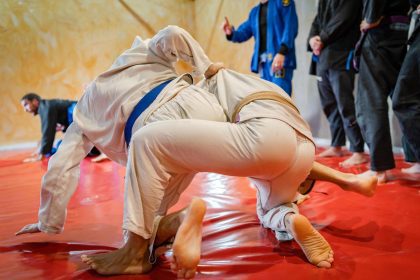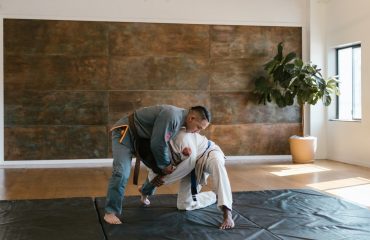
Brazilian Jiu-Jitsu (BJJ) is a martial art that emphasizes ground fighting and submission holds, but the journey to the mat often begins with a well-executed takedown. At NOCO Jiu-Jitsu and Self-Defense, we understand the importance of mastering takedowns in BJJ. This article delves into the techniques, tips, and training strategies to excel in BJJ takedowns, essential for both beginners and advanced practitioners.
Understanding BJJ Takedowns
Takedowns in Brazilian Jiu-Jitsu (BJJ) are maneuvers designed to take an opponent down to the ground. Differing from other martial arts, BJJ emphasizes ground control over the opponent, thus making takedowns an essential initial move for securing a favorable position.
The efficacy of takedowns in BJJ is not just about the physical act of bringing an opponent down; it’s about setting the stage for the entire bout. A well-executed takedown can significantly shift the momentum in your favor, allowing you to dictate the pace and flow of the match. This aspect of BJJ highlights the strategic nature of the art, where physical prowess is combined with tactical acumen. At NOCO Jiu-Jitsu and Self-Defense, we believe that understanding the intricacies of takedowns is as crucial as mastering the submission techniques that follow. It’s about creating opportunities, minimizing risks, and capitalizing on your opponent’s vulnerabilities right from the start. This holistic approach to takedowns is what sets apart proficient BJJ practitioners.
Single Leg Takedown: In this maneuver, you seize one of your adversary’s legs, typically by encircling the lower thigh with your arms, and utilize your leverage to topple them. It’s crucial to keep a firm hold and apply pressure against their knee with your shoulder while keeping your head close to their torso to block counterstrikes. Executing a single-leg takedown demands precise timing and nimbleness, as it’s most effective when the opponent is in motion or unsteady.
Double Leg Takedown: Similar to the single leg, but you attack both legs, offering more control and power. This move is initiated by lowering your level and driving forward into your opponent, wrapping your arms around their thighs. The double leg takedown is about combining speed with strength, as you lift and push your opponent off their feet. It’s a staple in BJJ due to its effectiveness and the dominant positions it can lead to on the ground.
Judo Throws: Incorporating Judo techniques, like the Ouchi Gari (Major Inner Reap) and Seoi Nage (Shoulder Throw), can be highly effective in BJJ. These throws involve unbalancing your opponent and using their momentum against them. Ouchi Gari is executed by sweeping the inside of an opponent’s leg while pulling them forward. In contrast, Seoi Nage involves a turning motion where you place your back against the chest and use leverage to flip it over your shoulder. These throws are technical and require precise timing and body movement.
Foot Sweeps: These are subtle yet effective methods for destabilizing your opponent and bringing them to the ground. Techniques like Deashi Harai (Advancing Foot Sweep) and Sasae Tsurikomi Ashi (Propping Foot Lift Pull) involve a quick sweep of the opponent’s foot or feet at the right moment, usually when they are shifting weight or moving. Foot sweeps are less about brute force and more about timing and understanding your opponent’s movement patterns. They can be particularly surprising and effective when executed correctly.
Drilling: Repetition is key in mastering any skill, and BJJ takedowns are no exception. Regularly practicing takedown techniques not only builds muscle memory but also increases your proficiency. It’s about ingraining every movement and reaction into your muscle fibers, so they become second nature. At NOCO Jiu-Jitsu and Self-Defense, we encourage consistent drilling, focusing on a variety of takedown techniques to prepare you for any situation you might encounter on the mat.
Strength and Conditioning: Enhancing your core strength, balance, and agility is crucial for effective takedown execution. These physical attributes contribute significantly to your ability to control and maneuver both your body and your opponent’s during a match. Strength training, coupled with specific conditioning exercises, is integrated into our training programs to ensure that you have the physical edge necessary for both initiating and defending takedowns.
Sparring Sessions: Sparring is where theory meets reality. Regular sparring sessions allow you to apply and refine techniques in a more realistic setting. These sessions are crucial for understanding how to adapt and apply takedowns against resisting opponents. At NOCO Jiu-Jitsu and Self-Defense, we provide a safe and controlled environment where you can test your skills, experiment with different strategies, and learn how to read and react to your opponent’s movements.
Learning from Failures: No journey is without its setbacks, and BJJ is no exception. Analyzing your sparring sessions and competitions to understand where your takedowns fail will provide valuable insights for improvement. This process involves reviewing your techniques, understanding the timing, and recognizing patterns in your approach that may need adjustment. Our coaches at NOCO Jiu-Jitsu and Self-Defense emphasize the importance of learning from these experiences, turning each failure into a stepping stone toward mastery.
Tips for Improving Your Takedowns
- Balance and Posture: The foundation of any successful takedown is a strong base and impeccable posture. Maintaining stability is not just about physical strength; it’s about understanding how to distribute your weight and align your body to resist and apply force effectively. This is essential not only for executing takedowns but also for defending against them. At NOCO Jiu-Jitsu and Self-Defense, we emphasize drills and exercises that enhance your core stability and posture awareness, crucial for achieving takedown mastery.
- Grips and Leverage: In BJJ, the concept of leverage is fundamental. Effective grips are not merely about holding your opponent; they are about controlling their movement and generating advantageous angles. Understanding the mechanics of leverage and how to apply it through various grips can transform your takedown efficiency. We focus on teaching the subtleties of grip strength, placement, and timing to turn seemingly simple holds into powerful tools for takedowns.
- Timing: Timing is a critical aspect of executing takedowns. It’s about reading your opponent, predicting their movements, and capitalizing on the moments they are most vulnerable. The best takedowns often come from a deep understanding of timing – striking just as your opponent shifts their weight or attempts a move. This requires not just physical training but also a keen sense of observation and anticipation, which we foster through simulated combat scenarios.
- Combining Techniques: BJJ is like a complex dance, where each move sets up the next. Combining techniques fluidly is essential for a well-rounded grappling repertoire. If your initial takedown attempt is countered, having the ability to seamlessly transition to another technique can catch your opponent off guard. This aspect of chaining techniques is a core part of our training philosophy, ensuring our students are adaptable and versatile in their takedown strategies.
- Mental Preparedness: An often overlooked aspect of takedowns is mental preparedness. Staying calm and focused under pressure, maintaining confidence, and possessing the mental toughness to persevere through challenges are crucial for success in BJJ. We encourage a mindset that views each training session and sparring match as an opportunity to develop not just physical skills, but also the mental resilience needed for effective takedown execution.
Incorporating Takedowns into Overall BJJ Strategy
At NOCO Jiu-Jitsu and Self-Defense, we stress the significance of incorporating takedowns into your comprehensive BJJ approach. A truly adept BJJ practitioner excels not only in ground techniques but also in effectively transitioning the fight to the ground.
This integration goes beyond mere technique; it involves developing an intuitive sense of when and how to execute takedowns within the broader context of a match. It’s about reading your opponent’s movements, anticipating their strategies, and seamlessly transitioning between standing and ground fighting. This comprehensive approach allows practitioners to maintain control over the fight, regardless of whether it’s on the feet or the mat. Emphasizing takedowns in training and sparring sessions at NOCO Jiu-Jitsu and Self-Defense ensures that our students are equipped with a diverse skill set, making them adaptable and formidable in any BJJ scenario. By treating takedowns as an integral part of the BJJ puzzle, rather than an isolated skill, we prepare our students for every twist and turn the sport has to offer.
The path to proficiency in BJJ takedowns involves ongoing education and practice. Concentrating on specific methods, and training approaches, and incorporating these abilities into your comprehensive BJJ skill set can greatly improve your experience in martial arts. At NOCO Jiu-Jitsu and Self-Defense, our dedication lies in assisting our students to excel in all areas of Brazilian Jiu-Jitsu, beginning from the instant the fight hits the ground.




